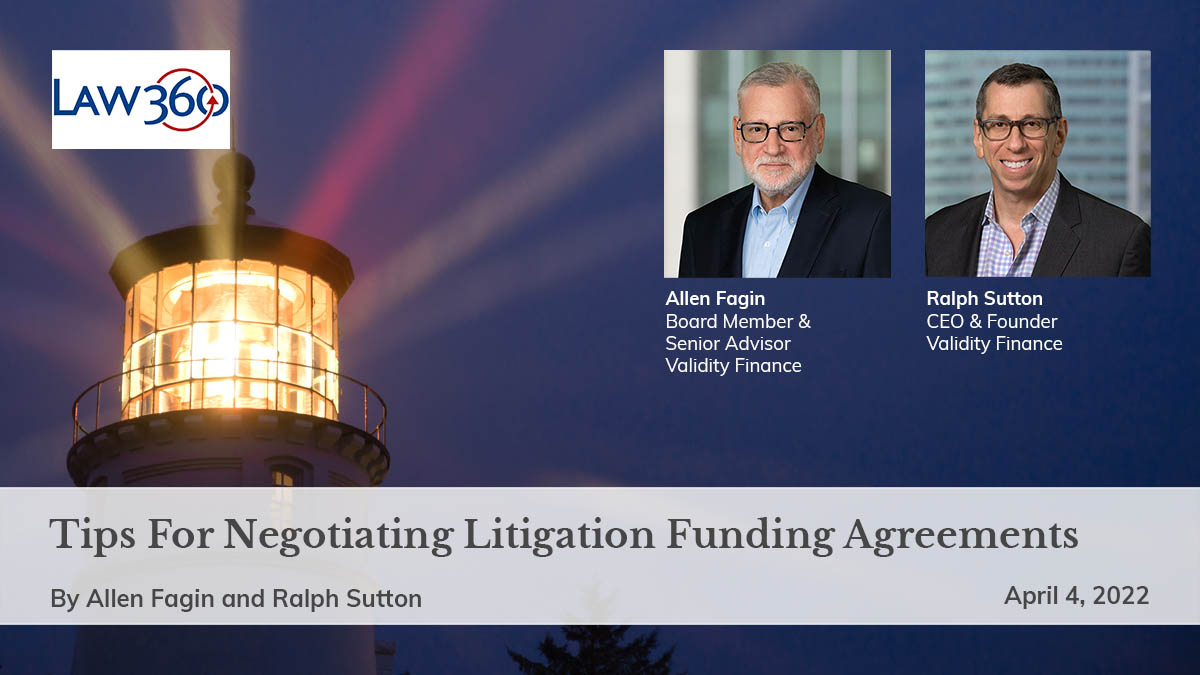April 4, 2022

Litigation funding is based on a relatively straight forward concept: a meritorious legal claim against a solvent defendant is an asset with value. Litigants, and their counsel of choice, can secure financing against the contingent value of that asset. This article provides some practical tips to law firm leaders as they consider potential litigation finance opportunities, and negotiate funding agreements.
Litigation funding typically happens in one of two ways: single case funding to companies and other claimholders, or multi-case “portfolio” funding to either claimholders or law firms. While the documentation of funding agreements will differ -- depending on whether a single case or portfolio of cases is being funded, and whether the agreement is between funder and claimant, or funder and law firm -- many of the key terms are common to any agreement. This article will focus primarily on single case funding to a claimholder. Here, the litigation finance company provides capital to be used for legal fees and expenses, such as expert costs and filing fees. Funding can also be provided to a company as working capital that can be immediately invested into the company’s business.
The funder's return is “non-recourse” -- it comes exclusively from case proceeds. If the case succeeds, the company reimburses the funder in accordance with the terms of their funding agreement.
After an initial assessment of case merits and potential damages, a funder interested in financing a case will typically send a term sheet detailing the scope and key economic terms of the proposed financing. Most term sheets are non-binding, but they set the overall framework for potential funding. These are several of the key terms typically found in funding term sheets that firm managers should pay particular attention to:
- Who is the Funded Party
Is the funded party the client, or the law firm directly? If the funder is contracting with the client, the commitments that the client makes in the funding agreement may implicate the law firm as well. For example, funds are usually paid to the lawyer’s escrow account, and often the law firm will need to acknowledge the funding agreement, and disburse the case proceeds upon resolution to the client and funder.
- Funding Amount; Timing of Payments; and Budget Over-runs
In the typical, single case funding with the client, the funder will provide a fixed dollar commitment for legal fees (constituting a designated percentage of the anticipated fee budget); a fixed dollar commitment for litigation expenses (constituting a designated percentage of the anticipated expense budget); and perhaps an additional amount payable to the client as working capital.
The funding agreement will specify the percentage of fees to be covered by the funder and by the firm, respectively; there may be room to negotiate these relative percentages depending on a variety of circumstances. It is essential for both the firm and the client to understand their contractual responsibility for covering any excess fees or expenses beyond the anticipated budgets.
Further, both the firm and the client should understand when the funded amounts will be paid. In some cases, funds in respect of fees and expenses are disbursed as incurred (this is known as “drip funding”). In other cases, funds may be disbursed on a mutually agreed schedule, based on certain case milestones, or other negotiated terms.
- How is the Funder’s Return Calculated?
Typically, the funder's return is based on a multiple of deployed capital, or a percentage of total case proceeds (or the greater of the two). Because the net return to the funder will vary based on the duration of capital deployment, the multiple or percentage will often increase based on the length of time to case resolution. Similarly, many funding agreements may include an “unexpected delay” provision, pursuant to which the standard return is increased if the case is not resolved within a designated, often lengthy time frame.
Make certain you understand the return structure. If a funder is asking for a return of “2x”, does this mean a multiple of the amount deployed, or the amount of capital committed? Deployed is typical in larger fundings, and can make a big difference where an early settlement is being considered. Similarly, does a “2x” return mean the funder gets its investment back plus 2x that amount, or do they get 2x in total (i.e., principal plus a 1x return?).
All parties should -- before entering into a funding agreement -- have full transparency around how the funder’s return and counsel’s contingency fee will be calculated, and what the implications of various recovery scenarios will be for client, counsel and funder. Key inputs to a resolution model will include the amount of funding deployed; the case resolution size; time to resolution; the return structure; transaction fees; bonuses (if any); and the waterfall, among others. Never hesitate to ask your funder for a resolution model (or models), and to review them with you so that they are fully transparent to you and your client. In a well-constructed funding, any reasonable resolution scenario should result in the claimant receiving the lion’s share of case proceeds, perhaps 50-60%.
- Definition of Case Proceeds
Where the funding agreement provides for the funder's return based on a percentage of case proceeds, it is important to understand what is included in that definition. Typically, partial or interim payments will be covered. Special care should be taken to understand how non- cash resolutions will be handled. For example, lawyers and clients should understand what happens if the case resolves through something other than an immediate payment from defendant to plaintiff, or if a plaintiff wins an injunction (or other form of non- monetary relief) rather than a damages award.
- Other Payments to Funder
Does the funding agreement contain any other payments to the funder beyond its return? For example, some funding agreements may include a structuring or transaction fee to the funder (which can be a specified dollar amount, or a percentage of the funder’s capital commitment.) If so, is the transaction fee paid at closing, or is it added to deployed capital? Check when fees are paid, and whether the funder earns a return on the fee.
The funding agreement may also include a “tail”return to the funder from one or more future cases which could only have been brought due to the successful funding of a first case.
Other term sheets or agreements may include “breakup fees”, payable if the case resolves during the underwriting process. It is important to understand when, and under what circumstances, such fees would be payable.
- The “Waterfall”
Funding agreements will typically include a “waterfall” provision, specifying how, and in what order, case proceeds are distributed. For example, a typical waterfall structure may look like this:
- 100% to the funder, until funder has received all of its deployed capital;
- thereafter, case proceeds are distributed pari passu and pro rata to the funder and the firm, until funder has received its full return and the firm has received its full contingent fee (or set percentages of each);
- thereafter, to the client.
Exactly what the waterfall looks like in any particular funded matter will typically depend on the case’s risk profile. Waterfalls may not matter when the case is fully successful; but where there is a smaller than anticipated resolution amount, the waterfall may determine how the bulk of the case proceeds are distributed.
Further, the waterfall structure may become complex where multiple or interim payments of case proceeds are being made over time, as when there are multiple defendants or cases. The impact of interim payments on a return structure that is based on a multiple that increases over time can create particularly knotty issues. As with any detailed finance agreement, getting legal advice from experienced finance counsel is imperative.
Finally, as was the case with the return structure, the operation of the waterfall under various scenarios should be modelled, and carefully reviewed with your funder. Many funders will provide “waterfall calculators” to aid in this process.
- Exclusivity
Does the funder maintain the exclusive right to negotiate a funding agreement with the client for some specific period of time following execution of the term sheet? If so, on what terms?
- Portfolio Funding
Law firms (or companies) with a high volume of litigation may obtain the benefits of litigation finance for a portfolio of cases. Portfolios typically consist of three or more cases; however, there is no upper limit on the number of cases that can be grouped together and funded within a portfolio. Portfolio finance offers the same benefits as single case finance, with the additional advantages of scale, diversification of risk, and access to a larger amount of capital. If the funder is providing funding directly to the law firm for a portfolio of cases, the agreement should make clear whether-- and under what circumstances-- new cases can be added to the portfolio.
Because a portfolio of cases is cross-collateralized, and often “diverse” (i.e., the portfolio does not share a common set of facts or issues of law), the funder’s return can frequently be more favorable to the claimholder or law firm than can be traditionally offered in single case funding. Likewise, return structures in portfolio funding will vary; for example, funders may agree to cap their returns at a multiple of committed or invested capital.
- Other Considerations
Funders will always want to maintain the right to be kept informed of case developments at appropriate times, and with appropriate regard for privilege and work product. However, in order to avoid ethical (and/ or statutory) constraints, the funder should never exercise control over case strategy or settlement decisions. Any funding agreement providing otherwise should be rejected out of hand.
After the term sheet has been executed, the funder will begin more extensive diligence on the case (or portfolio of cases.) This will include an assessment of case merits and legal theories of liability; potential models of damages; and paths or obstacles to recovery. Diligence will also include the parties’ litigation history and propensity to settle; the skill and experience of counsel; the trier of fact and likely venue; the ability of a defendant to pay a judgment; and numerous other factors that may affect likelihood of success, potential damages and ultimate recovery. Diligence may also involve consultation with experts, potential witnesses, and outside diligence counsel. Once the case clears the diligence stage, the parties will negotiate a definitive litigation investment agreement (often called the funding agreement.) The funding agreement will include commercial terms that have been agreed in the term sheet and will likely also address non-financial terms (such as the claimant’s representations and warranties).
While the funding agreement will contain certain provisions that are standard for funding or financial arrangements, there are some notable terms that should be carefully considered. The funding agreement will include representations and covenants which ensure that the claimant has provided funder with the information necessary for funder to diligence both the underlying litigation and the claimant’s corporate structure. Another key term of the funding agreement will revolve around the circumstances in which the agreement can be terminated, or in which the funder will no longer be obligated to provide funding. It is important that the claimant and its counsel review the funding agreement carefully to ensure that claimant is able to comply with the terms of the agreement throughout the life of the agreement.
Some Final Observations
It is both useful and appropriate for law firm leaders to view their relationship with funders much as they do their relationship with clients-- based on trust and long term relationship. While a particular funding will last for the life of a case, a truly productive relationship should endure well beyond, and across multiple engagements.
Finally, the key to a successful funding agreement-- for the client, counsel and the funder-- is absolute transparency and clarity. At the conclusion of a litigation, there should be no surprises about the disposition of case proceeds. The funder can help ensure this outcome by making complicated financial models simple to understand, and by walking clients and their counsel through potential scenarios before, during, and after litigation.
Allen Fagin is a senior advisor to Validity Finance. He is a former partner of Proskauer Rose, LLP, and served as the firm's Chair from 2005 to 2011.
Ralph Sutton is founder and CEO of Validity Finance.

